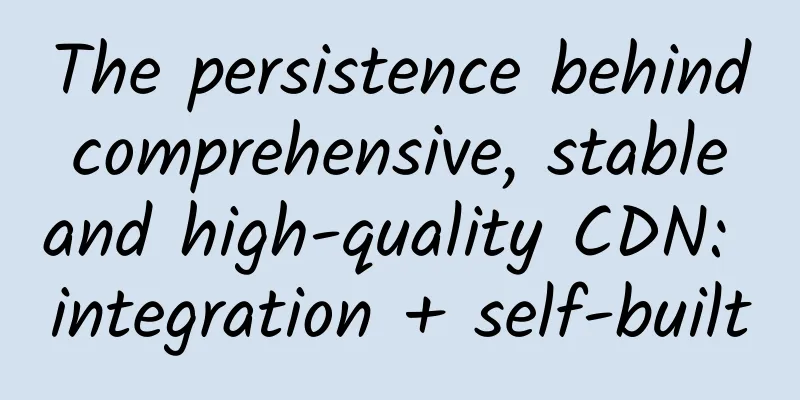The persistence behind comprehensive, stable and high-quality CDN: integration + self-built

|
On November 16, 2016, GFIC2016, hosted by DVBCN&AsiaOTT, was held in Shanghai. This year's ceremony brought together industry elites from video websites, OTT service providers, VR/AR application service providers, mobile live broadcast platforms, video e-commerce platforms, CDN service providers, public cloud service platforms and other fields to summarize the achievements of various industries in the past year, share the innovations and bottlenecks in the work throughout 2016, and meet the new challenges in the "Internet +" era. At the ceremony, Qiniu Cloud Technical Director Li Ruiqi put forward his own views and insights on the development of Qiniu Cloud's integrated CDN, the current use of CDN redundant resources, and how to reduce the cost of CDN products. Comprehensiveness, stability, and high performance have become the criteria in the competitive CDN market Qiniu Cloud is different from traditional CDN service providers and new public cloud service providers. The entire CDN product is provided to customers in a self-built + integrated manner. Li Ruiqi explained that many people would ask why integration is needed? In fact, integration is because Qiniu believes that the CDN industry has entered the red ocean of competing resources and prices from the original blue ocean market. Integration can not only create CDN products stably and quickly, but also reduce traffic costs as much as possible. Serving users with quality optimization and cost optimization is the purpose of integrated CDN. Looking at the CDN industry, traditional CDN giants and operators such as Wangsu and ChinaCache have been deeply involved in this industry for more than ten years. They have great advantages in resources, and emerging cloud vendors have entered the CDN industry with self-service configuration concepts and new edge caching technologies to compete with traditional vendors. According to statistics, there are at least 20 to 30 well-known vendors in the current CDN industry, which has led to a large number of redundant idle resources in the entire CDN industry. If Qiniu can integrate these resources well, it can achieve the so-called integrated CDN. The purpose of Qiniu Cloud is to provide users with a comprehensive, stable, and high-performance CDN. This is the basic demand of all Internet users, and it is also the path pursued by all CDN products of Qiniu Cloud. The so-called "comprehensive" means more comprehensive coverage. Qiniu can build more than 100 points in China and cover domestic users well, but what about the needs of overseas users? What about the problem of global coverage? In every international region, it is actually difficult to spread nodes to every corner. At this time, the self-built + integrated approach can integrate the entire national or global network together to provide high-quality CDN services for the entire network. Stability - When CDNs are integrated, customers with bandwidths of more than tens of G will not choose only one CDN. There may be many reasons, such as mutual backup, introducing competition, improving service quality, or some manufacturers' CDNs have no resources and poor service quality in certain areas. "Integration" undoubtedly has many advantages, but how to integrate these resources together and ensure stability? Allocating by ratio, weight, and region are all ways of integration. Qiniu has an independent understanding of the CDN industry, and its unique integration method is enough to achieve greater stability and higher quality. In terms of performance, Qiniu will use its own fusion technology and evaluation criteria to evaluate the performance of various CDN vendors, our self-built nodes, and nodes in each region, so as to achieve better overall network performance. Advantages and Disadvantages of Fusion CDN in Red Sea CDN Environment Qiniu's integration combines the nodes of mainstream CDN service providers with the 150+ nodes built by Qiniu Cloud. Even if Qiniu's self-built CDN is increasingly deployed in the future, Qiniu will not abandon integration. Integration has become a brand of "Qiniu". The advantages of integrated CDN are many, including comprehensive coverage and no blind spots (some gray areas appear in some marginal areas, that is, areas without node coverage). Through the idea of integration, any area can be covered by nodes. Even if Qiniu does not have its own points, there are more than a dozen manufacturers to choose from to achieve node-level mutual backup. Maybe customers really don’t monitor the quality of a CDN when they use it? In the bidding process, manufacturers generally put out the best resources. But once the bidding is passed, or after a period of use, such as a month, its overall quality will slowly decline. Eventually, when the service quality continues to decline and drops to an unstable state, many customers may report that the CDN quality is not good, and then the service provider will help you adjust it. But this approach is not Qiniu’s attitude towards CDN. What Qiniu insists on doing is to provide high-quality CDN. Only long-term uninterrupted optimization can ensure the high quality of CDN. Of course, there are some disadvantages to fusion CDN. Some people say that the nodes are not owned by Qiniu, and Qiniu cannot control these nodes well. How to deal with the failure of the node in time? It is precisely because Qiniu cannot control these nodes that we have added an external monitoring system. Qiniu provides a complete monitoring system to ensure the stable operation of fusion CDN. If you use a service now and it has a 520 error, but it does not automatically switch away, then this manufacturer is very problematic. Qiniu Cloud's monitoring system is sufficient to achieve timely monitoring and timely switching. With the development of CDN industry for more than ten years, the technologies of various companies have become very mature, and even many new small manufacturers have emerged, and the technical threshold has become relatively low. At this time, the entire industry has entered an era of competing for resources and prices, which is why many securities companies and capitals believe that CDN has entered a red ocean. Integrated intelligent scheduling provides guarantee for CDN's real-time and accurate distribution requirements When a user needs to access CDN, when the data needs to be accelerated, it will enter the acceleration phase of the integrated CDN. Qiniu will first schedule and switch by region. If the performance of the entire Qiniu node in Guangdong is not so good, Qiniu will try to use intelligent scheduling to connect resources from other manufacturers. In addition to switching by region, Qiniu also has a complete set of quality system guarantees to ensure the quality of the entire line through operational integration. When we were integrating, we found that the technical strength of many CDN manufacturers was actually very average. The so-called intelligent scheduling focuses on two points. The first point is the node-level traffic balance and mutual backup. Focus on balance and mutual backup. Another point in intelligent scheduling is precision. How to achieve precision? The three different scheduling methods are different. 99% of suppliers use DNS scheduling. Its advantage is that it is universal. The disadvantage is that it is uncontrollable. Because DNS resolution uses local DNS for caching, Local DNS is uncontrollable. How to decide which cache point to give it? Unfortunately, the Local DNS mentioned above will not pass through the client IP. If the egress DNS does not match the user's node, the scheduled node is wrong. The second scheduling method is HTTP DNS, which is very popular in the industry. HPPT DNS means passing the user's IP to the scheduler, doing a heartbeat every minute, passing the user's IP, and saying which IP this domain name resolution is, and caching it locally. Assuming my heartbeat is once every 1 minute, if the node hangs, it will only affect one minute. The disadvantage is that it requires SDK and terminal support. ***One is IP 302. Before a request is made, the request is first directed to the scheduler. The scheduler generates 302, telling you where to get the file. This allows for accuracy because all requests generate 302 in real time. If a node goes down, the traffic at that point can be cut off at any time. This is the consideration of accuracy in Qiniu's fusion scheduling. On Qiniu's fusion platform, all three scheduling methods can be used. Qiniu ensures user experience through real-time monitoring, integrated scheduling, and quality operations. It removes poorly performing nodes in a timely manner and selects the best quality resources and integrates them together. Operation optimization and Spider monitoring provide user experience assurance When Qiniu is providing integrated CDN services, we always keep in mind that only long-term and uninterrupted operation optimization can ensure high-quality CDN services. CDN has entered the red ocean, and if it is not optimized, the service will deteriorate. The quality monitoring in the industry does not meet the needs of CDN. What we need is such a system. As long as we open the system after work every morning, we can know what problems happened yesterday. In terms of monitoring, Qiniu is a converged CDN, and really hopes to make its own technical style. Qiniu is not reselling other people's resources, which is not called convergence at all. Real convergence is to have its own unique value. If the CDN is strong enough, it will generally promote its own edge, including the intelligent scheduling system. In fact, intelligent scheduling is only responsible for making quick decisions, and the real decision-making basis is monitoring. So if you want to do a good job of CDN and intelligent scheduling, you must first do a good job of monitoring. If you don't know what's wrong with your CDN, you can't schedule it. But when you do a converged CDN, the nodes are not yours, so how can you implement monitoring? If you don't even know the IP, how can you monitor? Here you need Spider. After the manufacturer completes the configuration, they will give you a CName, a CNmae to define a group of resource coverage. Qiniu will use Spider to capture the distribution of coverage nodes across the country and even the world. Although the Local DNS of the entire Internet cannot transmit IP transparently, it can still be captured with Spider. In Shanghai, you can also simulate the IPs of Beijing, Shenzhen, and various regions of the United States to request the authoritative server, and then you can know how many nodes cover these physical addresses. With this data, you can count how authentic the coverage given to you by the manufacturer is. Spider can obtain node distribution in real time, and capture the IP distribution of the whole country and even the world every two minutes. The IP is in the database, and you can decide independently how to choose the node, which is enough to realize scheduling. Second, there must be monitoring, and it cannot be adjusted casually. In theory, your scheduling monitoring can only make some decisions when it finds a downtime. The third is very important, which is to follow the weight. If the manufacturer's node is taken and scheduled at will, and the computer room needs to be repaired or the traffic needs to be temporarily taken away, you are still scheduling it, which is digging a hole for yourself. Follow is very important. If someone else takes down the node or the weight changes, we should all follow the real-time weight distribution. The last point is that scheduling solves node performance, and operation solves coverage performance. Qiniu has been working on integrated CDN for nearly two years and has accumulated a lot of experience and management capabilities for massive operations. Faced with the CDN red ocean, Qiniu believes that only by insisting on self-construction + integration to complement each other can it provide comprehensive, stable and high-quality CDN services. |
<<: The threat of cyber espionage
>>: How to understand 5G air interface (NR)?
Recommend
5G will make your 4G mobile phone obsolete. How can you become a "pig" in the 5G trend?
[[223756]] According to Gartner data, the total s...
Failure to modernize data center infrastructure increases costs and risk of downtime
Today's data centers are more dynamic than ev...
Smart city becomes the new name card of Lanzhou New District: new momentum for the new district breeds new development
[51CTO.com original article] Not long ago, the 20...
RAKsmart New Year Event: E3 servers starting at $30/month, 30% off on all VPS, popular VPS starting at $1.99/month
RAKsmart is a foreign hosting company operated by...
When will 5G take off and cover more than 1 billion people worldwide by the end of this year?
2019 is the "first year" of 5G commerci...
LiFi looks good, but it is difficult to pass the market test
10 days ago, pureLifi raised $18 million in Serie...
TmhHost adds dual ISP US home broadband VPS native IP/AS9929 backhaul monthly payment starts from 50 yuan
This month, TmhHost added dual ISP home broadband...
How hard do communication networks work to save power?
The energy consumption of communication networks ...
HostXen offers 50 yuan for new users, 50 yuan for old users who charge 300 yuan, and monthly payment for 6G memory package starts from 70 yuan
HostXen launched its first promotion after the Lu...
Sharktech: $99/month-2*E5-2670V2/32G memory/500G SSD disk/1Gbps unlimited traffic/Los Angeles data center
Sharktech is a long-established DC merchant in th...
[Black Friday] DesiVPS: $17/year-1GB/15G NVMe/1.5TB@10Gbps/San Jose Data Center
DesiVPS also launched a Black Friday promotion, m...
WiFi signal is strong but speed is slow? Here’s how to fix it!
The company's wireless WiFi signal is strong,...
Insufficient coverage: South Korean 5G users can access 5G networks only 15% of the time
According to Yonhap News Agency, a report from in...
iONcloud November: San Jose optimization/Los Angeles monthly payment of $11.11 and annual payment of $111.1
iONcloud's Double 11 promotion runs throughou...
spinservers: 100M-1Gbps unlimited traffic servers starting from $118/month, Silicon Valley/Dallas data centers
spinservers launched its first promotion after th...









